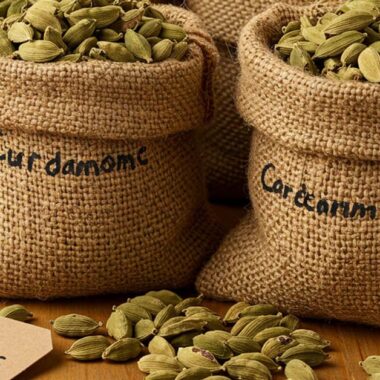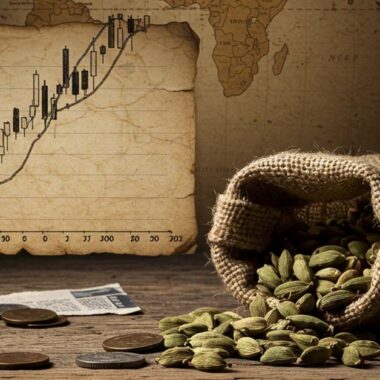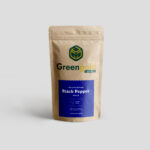In recent years, technology has become a game-changer in agriculture, offering new opportunities for efficiency, sustainability, and productivity. For cardamom farmers, embracing modern technology can be the key to higher yields, better quality, and improved profitability. As one of the world’s most sought-after spices, the demand for cardamom has been steadily rising, and the integration of technology into farming practices can help meet this growing demand. 🌍🚜
In this blog, we’ll dive into how technology is transforming cardamom farming, enhancing crop management, disease control, and even the way cardamom is harvested and marketed. Let’s explore the future of cardamom farming and how it’s evolving with the help of technology. 💡
📱 Technological Innovations in Cardamom Farming
1. Precision Farming Tools
Precision farming involves using advanced tools and technologies like drones, GPS, and soil sensors to monitor and manage crop health, irrigation, and soil conditions more accurately. 🌱
- Soil Sensors: These sensors measure soil moisture, temperature, pH levels, and nutrient content, providing farmers with real-time data to optimize their irrigation and fertilization strategies. 🌿
- Drones: Drones equipped with high-resolution cameras help farmers monitor large plantations by capturing aerial images that show crop health, pest infestations, and any signs of disease. This allows farmers to take targeted actions where necessary, saving time and resources. 🚁
- GPS Technology: By using GPS-guided tractors and harvesters, farmers can reduce wastage of fertilizers, water, and energy, ensuring that resources are used as efficiently as possible. 🌍
2. Smart Irrigation Systems
Cardamom requires high humidity and consistent rainfall to grow well, but ensuring proper irrigation can be a challenge, especially in areas with water scarcity. Smart irrigation systems powered by IoT (Internet of Things) and weather forecasting technology help farmers optimize water use. 💧
- Automated Irrigation: With IoT-enabled systems, irrigation can be automated based on soil moisture levels, ensuring crops receive the right amount of water at the right time, without overuse. 🌿
- Weather Forecasting: By integrating weather data, farmers can plan irrigation schedules based on upcoming rainfall, saving water and reducing costs. 🌧️
3. Crop Monitoring and Disease Management
Monitoring cardamom crops for pests, diseases, and nutrient deficiencies is crucial to maintaining high-quality produce. With the help of technology, farmers can detect problems early and take swift action to protect their crops. 🔬
- Mobile Apps: There are now several mobile apps designed for farmers that allow them to track the health of their crops, get pest alerts, and access advice on plant diseases and remedies. 📲
- AI & Machine Learning: Artificial intelligence (AI) and machine learning can help predict pest outbreaks and disease patterns by analyzing weather data, historical trends, and crop health. This can help farmers prevent issues before they become widespread, reducing the need for pesticides and minimizing crop loss. 🤖
4. Improved Harvesting Techniques
Harvesting cardamom is a labor-intensive process that requires careful timing to ensure the best quality. Modern harvesting techniques, supported by technology, can help farmers optimize their yield while minimizing damage to the crops. 🍃
- Automated Harvesters: There are machines designed to automate the harvesting of cardamom pods, reducing labor costs and speeding up the process. While manual harvesting is still common, automated harvesters can assist in larger plantations. 🚜
- Harvesting Apps: Some apps allow farmers to track the maturity of cardamom pods using photos and algorithms. These apps can recommend the perfect time for harvesting, ensuring that cardamom is picked at its peak. ⏰
5. Blockchain for Transparency in the Supply Chain
In the cardamom market, transparency is crucial, especially when it comes to ensuring the authenticity and quality of the product. Blockchain technology is being used to track cardamom from the farm to the final consumer, ensuring that the product is ethically produced and traceable. 🔗
- Supply Chain Tracking: Blockchain allows for secure, transparent records of every transaction in the supply chain, from harvest to sale, ensuring that cardamom reaches consumers without issues related to fraud or quality concerns. 📦
- Fair Trade: Blockchain can also be used to track whether cardamom is produced under fair trade practices, ensuring that farmers receive a fair price for their labor. 💰
6. E-Commerce and Digital Marketing for Farmers
With the rise of online marketplaces, cardamom farmers can now reach customers directly, eliminating the need for middlemen. Digital marketing tools allow farmers to advertise their products on social media, e-commerce platforms, and even their own websites. 🌐
- Online Platforms: Platforms like Amazon, Flipkart, and specialized spice marketplaces offer farmers a direct channel to sell their cardamom products to both local and international consumers. 🛒
- Social Media Marketing: Farmers can use platforms like Instagram, Facebook, and YouTube to market their cardamom products, share their story, and engage with potential customers, increasing their visibility and sales. 📸
🌱 Benefits of Technology in Cardamom Farming
1. Increased Productivity and Efficiency
By using technology, farmers can make informed decisions about crop management, ensuring that their resources are used efficiently, which leads to higher yields and reduced waste. 🌾
2. Reduced Costs
Automation and precision farming can help farmers reduce their operational costs, such as water usage, fertilizer application, and labor. 💸
3. Improved Crop Quality
With the help of technology, farmers can better manage their crops, ensuring that the cardamom harvested is of higher quality. This results in better market prices and consumer satisfaction. 🌟
4. Sustainability
Technology-driven practices like smart irrigation, pest management, and organic farming techniques help promote sustainability in cardamom farming, ensuring that the industry remains viable for generations to come. 🌍
🌿 Conclusion
Technology is revolutionizing cardamom farming, making it more efficient, profitable, and sustainable. From precision farming tools to smart irrigation systems and blockchain technology, innovations in agriculture are helping farmers overcome challenges and improve their livelihoods. 🌾🚜
As cardamom continues to be in high demand worldwide, embracing these modern technologies will be essential for farmers looking to stay competitive and meet market demands. By adopting technology, farmers can ensure that their cardamom production is sustainable, efficient, and profitable for years to come. 🌍













